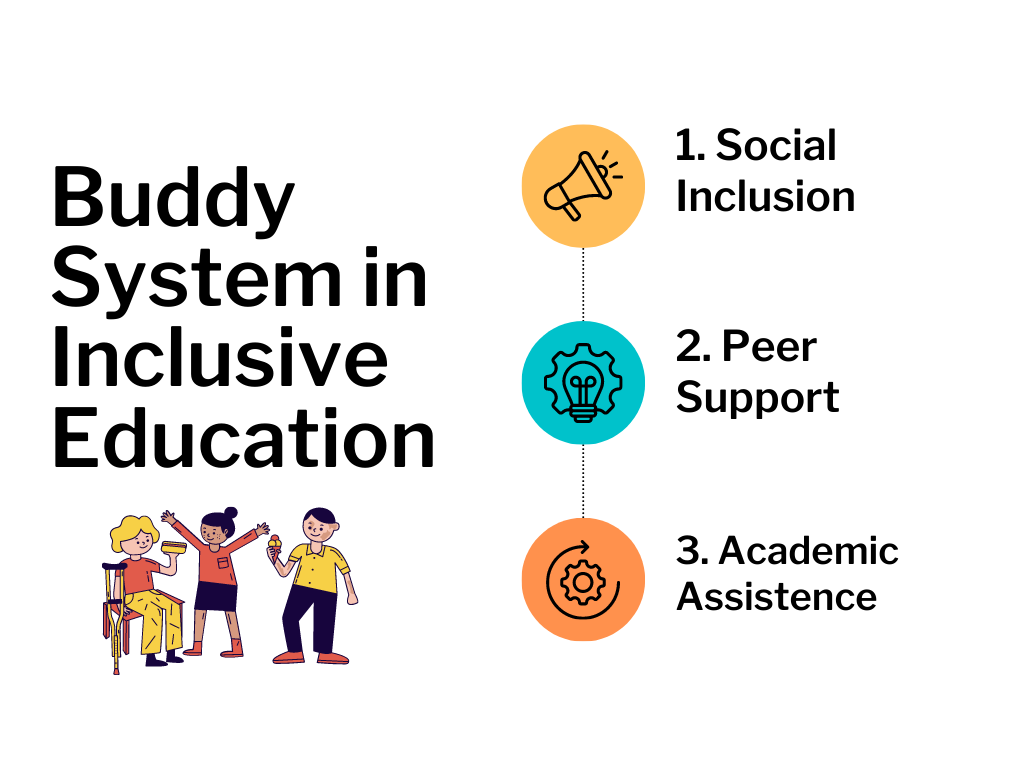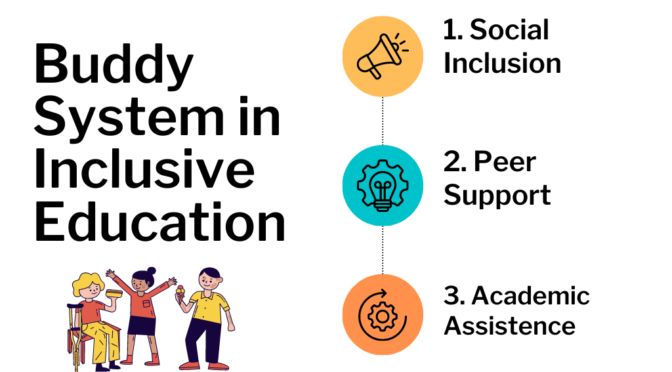The buddy system in inclusive education refers to a supportive practice where students with disabilities or special needs are paired with typically developing peers or “buddies” in an inclusive classroom setting. The purpose of the buddy system is to promote social inclusion, peer support, and academic success for students with disabilities.
Here are some key points about the buddy system in inclusive education:
- Social inclusion: The buddy system helps foster a sense of belonging and acceptance for students with disabilities. It encourages social interaction and friendships between students with diverse abilities, promoting an inclusive school environment.
- Peer support: Buddies provide support to their peers with disabilities by assisting them with various activities, such as classroom assignments, projects, or navigating the school environment. They offer guidance, encouragement, and friendship, which can enhance the self-esteem and confidence of students with disabilities.
- Academic assistance: Buddies can help students with disabilities in their academic pursuits. They may provide tutoring, clarification of concepts, or assistance with classroom tasks. This collaborative approach can contribute to improved learning outcomes for students with disabilities.
- Role modeling: Buddies act as positive role models for students with disabilities. They demonstrate appropriate social behaviors, empathy, and understanding, which can influence inclusive attitudes among all students. The buddy system promotes empathy, respect, and acceptance of individual differences.
- Increased participation: With the support of their buddies, students with disabilities are encouraged to actively participate in classroom activities, discussions, and group work. The presence of a buddy can help reduce anxiety and provide a safety net for students with disabilities to engage in the learning process.
- Reciprocal benefits: The buddy system is not a one-way support system. Buddies also benefit from the experience by developing empathy, understanding, and acceptance of differences. They learn valuable life skills, such as patience, cooperation, and communication.
- Individualized support: The buddy system allows for personalized support based on the specific needs of each student with a disability. Buddies can adapt their approach to cater to the unique learning styles and abilities of their assigned buddy, creating a more inclusive and individualized learning environment.
The implementation of the buddy system requires careful planning, training, and ongoing support from educators and school staff. It is crucial to establish clear expectations, monitor the dynamics between buddies, and provide opportunities for reflection and feedback to ensure the success of the inclusive education model.
Also Read : Team Teaching Model of Inclusion

Also Visit : Prep with Harshita


Interesting post right here. One thing I’d like to say is that often most professional domains consider the Bachelors Degree like thejust like the entry level standard for an online diploma. Though Associate Certification are a great way to get started on, completing your Bachelors uncovers many entrance doors to various jobs, there are numerous internet Bachelor Course Programs available through institutions like The University of Phoenix, Intercontinental University Online and Kaplan. Another concern is that many brick and mortar institutions make available Online variants of their degree programs but usually for a greatly higher payment than the companies that specialize in online education programs.
equilibrado estatico
Dispositivos de equilibrado: esencial para el operación estable y productivo de las dispositivos.
En el campo de la tecnología actual, donde la rendimiento y la estabilidad del dispositivo son de suma trascendencia, los dispositivos de ajuste cumplen un tarea esencial. Estos aparatos adaptados están diseñados para calibrar y estabilizar elementos móviles, ya sea en maquinaria industrial, medios de transporte de desplazamiento o incluso en equipos domésticos.
Para los expertos en mantenimiento de aparatos y los profesionales, trabajar con equipos de balanceo es crucial para asegurar el rendimiento uniforme y confiable de cualquier aparato giratorio. Gracias a estas soluciones avanzadas sofisticadas, es posible limitar sustancialmente las movimientos, el ruido y la tensión sobre los cojinetes, extendiendo la duración de piezas valiosos.
Asimismo trascendental es el papel que cumplen los dispositivos de balanceo en la asistencia al consumidor. El soporte especializado y el reparación regular empleando estos dispositivos posibilitan ofrecer prestaciones de excelente calidad, elevando la bienestar de los compradores.
Para los propietarios de empresas, la inversión en sistemas de ajuste y sensores puede ser fundamental para optimizar la eficiencia y productividad de sus equipos. Esto es principalmente relevante para los inversores que administran pequeñas y modestas organizaciones, donde cada aspecto vale.
Por otro lado, los sistemas de calibración tienen una gran utilización en el área de la prevención y el control de calidad. Facilitan encontrar eventuales fallos, reduciendo reparaciones caras y perjuicios a los aparatos. Además, los datos generados de estos sistemas pueden usarse para mejorar sistemas y aumentar la visibilidad en motores de búsqueda.
Las campos de utilización de los aparatos de ajuste comprenden diversas sectores, desde la elaboración de vehículos de dos ruedas hasta el monitoreo ambiental. No influye si se trata de importantes elaboraciones productivas o modestos talleres de uso personal, los sistemas de ajuste son esenciales para asegurar un desempeño productivo y sin presencia de paradas.
You can definitely see your skills in the work you write. The world hopes for even more passionate writers like you who aren’t afraid to say how they believe. Always go after your heart.
Vipertoto login
tvxsjl
monkey mart unblocked?
[b]How to Prevent Dangerous Imbalance and Extend Equipment Lifespan?[/b]
Vibration issues in industrial machinery lead to increased wear, higher energy costs, and unexpected failures. [b]Balanset-1A[/b] is a professional portable balancer and vibration analyzer designed to detect and correct imbalance in rotors, fans, turbines, and other rotating equipment.
[b]Why choose Balanset-1A?[/b]
– High-precision vibration diagnostics
– Easy-to-use software
– Compact and portable design
– Two kit options to meet your needs:
[url=https://www.amazon.es/dp/B0DCT5CCKT]Full Kit on Amazon[/url]: Balanset-1A device, Vibration sensors, Software & mounting accessories, Hard carrying case
Price: [b]2250€[/b]
[url=https://www.amazon.es/dp/B0DCT5CCKT][img]https://i.postimg.cc/SXSZy3PV/4.jpg[/img][/url]
[url=https://www.amazon.es/dp/B0DCT4P7JR]OEM Kit on Amazon[/url]: Balanset-1A device, Basic sensors, Software
Price: [b]1978€[/b]
[url=https://www.amazon.es/dp/B0DCT4P7JR][img]https://i.postimg.cc/cvM9G0Fr/2.jpg[/img][/url]
Ensure longer equipment lifespan and reduce costly downtime with [b]Balanset-1A[/b].
This is really interesting, You are a very skilled blogger. I have joined your rss feed and look forward to looking for more of your fantastic post. Additionally, I’ve shared your web site in my social networks!
There’s noticeably a bundle to know about this. I assume you made certain nice points in options also.
I think this is one of the most important information for me. And i’m glad reading your article. But should remark on few general things, The web site style is perfect, the articles is really great : D. Good job, cheers
Регистрация на официальном портале Up X
Регистрация в Up X — простой и быстрый процесс. Вам не придется выделять много времени, чтобы стать клиентом сервиса. Создатели платформы позаботились не только о стильном дизайне, но и о том, чтобы она воспринималась интуитивно. Минимализм и продуманный интерфейс — отличная комбинация. С созданием профиля не будет никаких проблем
https://skachatreferat.ru/
Chicken Road: Real Player Feedback
Chicken Road is an arcadestyle gambling game that has caught the attention of players with its simplicity, high RTP (98%), and unique cashout feature. By analyzing user opinions, we aim to figure out whether this game deserves your attention.
What Users Appreciate
Numerous players commend Chicken Road for its quick, engaging action and userfriendly design. The option to withdraw winnings whenever you want introduces a tactical element, and the high RTP ensures it feels more equitable compared to classic slots. Beginners love the demo mode, which lets them try the game without risking money. Players also rave about the mobilefriendly design, which performs flawlessly even on outdated gadgets.
Melissa R., AU: “Unexpectedly enjoyable and balanced! The ability to cash out brings a layer of strategy.”
Nathan K., UK: “The arcade style is refreshing. Runs smoothly on my tablet.”
Players also enjoy the colorful, nostalgic design, which feels both fun and engaging.
Areas for Improvement
Despite its strengths, Chicken Road isn’t without flaws. A number of users feel the gameplay becomes monotonous and lacks complexity. Others mention slow customer support and limited features. A common complaint is misleading advertising—many expected a pure arcade game, not a gambling app.
Tom B., US: “Initially enjoyable, but the repetition kicks in after a short while.”
Sam T., UK: “Advertised as a fun game, but it’s clearly a gambling app.”
Pros and Cons
Positive Aspects
Easytounderstand, quick gameplay
With a 98% RTP, it offers a sense of equity
Free demo option for beginners to test the waters
Smooth performance on mobile devices
Cons
The gameplay may come across as monotonous
Not enough features or modes to keep things fresh
Customer service can be sluggish and unreliable
Deceptive advertising
Conclusion
Thanks to its transparency, high RTP, and userfriendliness, Chicken Road makes a mark. Ideal for casual gamers or anyone just starting with online gambling. However, its reliance on luck and lack of depth may not appeal to everyone. For optimal results, choose verified, legitimate platforms.
Rating: Four out of five stars
A fair and entertaining choice, but not without room for improvement.
chicken road rtp
Chicken Road: What Gamblers Are Saying
Chicken Road is a gamblinginspired arcade game that has drawn interest due to its straightforward mechanics, impressive RTP (98%), and innovative cashout option. We’ve collected honest feedback from actual players to see if it lives up to expectations.
What Users Appreciate
Many users praise Chicken Road for its fastpaced gameplay and ease of use. The option to withdraw winnings whenever you want introduces a tactical element, and the high RTP ensures it feels more equitable compared to classic slots. Beginners love the demo mode, which lets them try the game without risking money. Mobile optimization also gets high marks, as the game runs smoothly even on older devices.
Melissa R., AU: “Unexpectedly enjoyable and balanced! The ability to cash out brings a layer of strategy.”
Nathan K., UK: “The retro arcade vibe feels invigorating. Plus, it works perfectly on my tablet.”
The bright, nostalgic visuals add to the fun factor, keeping players hooked.
Drawbacks
However, Chicken Road isn’t perfect, and there are a few issues worth noting. Certain players think the game is too predictable and doesn’t offer much variety. Others mention slow customer support and limited features. Misleading ads are another issue, with many assuming it was an arcade game instead of a gambling app.
Tom B., US: “Initially enjoyable, but the repetition kicks in after a short while.”
Sam T., UK: “Marketed as a casual game, but it’s actually a gamblingfocused app.”
Strengths and Weaknesses
Advantages
Simple, fastpaced gameplay
High RTP (98%) ensures fairness
Practice mode to explore without financial risk
Optimized for flawless mobile play
Negative Aspects
The gameplay may come across as monotonous
Lack of diversity and additional options
Slow or unresponsive customer support
Misleading marketing
Final Verdict
Thanks to its transparency, high RTP, and userfriendliness, Chicken Road makes a mark. Perfect for relaxed gaming sessions or newcomers to online betting. However, its reliance on luck and lack of depth may not appeal to everyone. To maximize enjoyment, stick to authorized, regulated sites.
Rating: A solid 80%
An enjoyable and equitable option, though it has areas to grow.